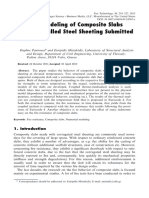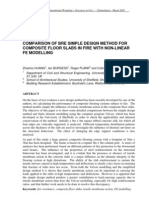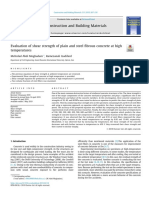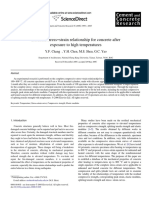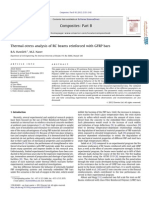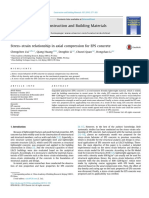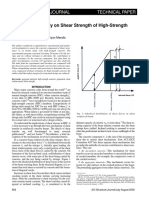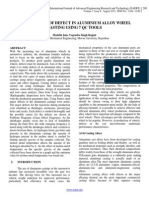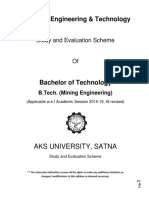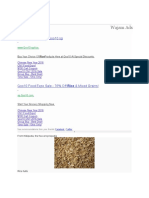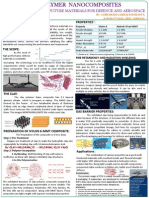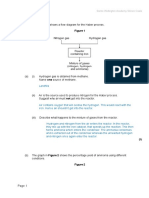Nonlinear Analysis of Reinforced Concrete Slabs at Elevated Temperature
Nonlinear Analysis of Reinforced Concrete Slabs at Elevated Temperature
Uploaded by
Huda JawadCopyright:
Available Formats
Nonlinear Analysis of Reinforced Concrete Slabs at Elevated Temperature
Nonlinear Analysis of Reinforced Concrete Slabs at Elevated Temperature
Uploaded by
Huda JawadOriginal Description:
Original Title
Copyright
Available Formats
Share this document
Did you find this document useful?
Is this content inappropriate?
Copyright:
Available Formats
Nonlinear Analysis of Reinforced Concrete Slabs at Elevated Temperature
Nonlinear Analysis of Reinforced Concrete Slabs at Elevated Temperature
Uploaded by
Huda JawadCopyright:
Available Formats
Nonlinear Analysis of Reinforced Concrete Slabs at
Elevated Temperature
Ayad A. Abdul-Razzak 1
Ahmed Hadee Said 2
Received: 3 June 2010; Accepted: 7 October 2010
Abstract
In this paper a nonlinear finite element analysis is presented to simulate the fire resistance of
reinforced concrete slabs at elevated temperatures. An eight node layered degenerated shell element
utilizing Mindlin/Reissner thick plate theory with initial stiffness technique is employed. The
proposed model considered cracking, crushing, and yielding of concrete and steel at high
temperatures. More complicated phenomena like concrete transient thermal strain and concrete
spalling are excluded in the present analysis. The validation of the proposed model is examined
against experimental data of previous researches and shows good agreement.
Key Words: Fire resistance, Material nonlinearity, Reinforced Concrete Slabs
( )
.
.
1. Introduction
The Research into the effect of fire on concrete, steel, and reinforced concrete structures has been
conducted since at least 1922 (as shown by Schneider [1]). The main areas of interest are [2]: the
understanding of the complex behaviour of the material itself, and the structural safety and integrity
of the building during and after the fire. The analytical prediction of reinforced concrete structures
at high temperatures back to 1970s. The thermal and structural analysis are interfaced and not
integrated. In other words, the temperatures distribution within the structural element due to
temperature rise is first calculated for the entire duration of temperature exposure, and then fed into
the structural analysis program to produce the stresses and strains for the structures [2].
The Nizamuddin and Bresler [3] presented a nonlinear finite element computer program FIRESSL for the analysis of reinforced concrete slabs at fire. The analysis based on Kirchhoff thin plate
theory and includes the coupling of bending and membrane action. Borst and Peeters [4] developed
an algorithm which simultaneously considers the effects of thermal dilatation, degradation of the
1
2
Assistant professor at the Civil Engineering Department, University of Mosul.
A M.Sc. student at the Civil Engineering Department, University of Mosul.
42
Ayad A. Abdul-Razzak and Ahmed Hadee Said
Iraqi Journal of Civil Engineering Vol. 9, pp. 42-51.
elastic properties with increasing temperature, transient thermal strain, and smeared cracking to
simulate plain and reinforced concrete at high temperatures. Results of the presented model show a
good agreement with experimental tests for both plain and reinforced concrete models. Huang et al
[5] developed a nonlinear finite element approach to enable practical modelling of fairly large
composite steel/concrete frames under the influence of compartment fire and external loading.
Again the validity of the proposed models show a good agreement with experimental results.
Ahmed and Al-Zubaedi [6] used the finite difference method to study the nonlinear structural
behaviour of reinforced concrete plates. Large deflection theory and dynamic relaxation technique
were used to calculate the strains and stresses in the plate at elevated temperature.
Ahmed and Hasan [7] study the effect of cyclic heating and cooling on the nonlinear behaviour
of reinforced concrete slabs at different load conditions before and after cracking up to failure.
Finite difference method with dynamic relaxation technique was used in the solution of the
differential equations.
The structural response involves the behaviour of reinforced concrete slabs which its constitutes
were affected by temperature rise under the applied load. In the present work, the combined effect
of the two responses is systematically evaluated using computer software presented by Owen and
Figueiras [8]. The software is modified in order to accommodate the evaluation of temperature
exposure as well as the structural response. Transient thermal strain which is a function of
temperature rise and applied load [9] and greatly affected the overall response of concrete slabs at
high temperature, and concrete spalling which can expose steel reinforcement to much higher
temperatures, causing further degradation of slab strength and stiffness, these two phenomena were
especially excluded from the present research.
2. Problem Material Constitutive Relationships at
Elevated Temperature
2.1 Biaxial Concrete State
At present, there is still little data and few theoretical models available concerning the constitutive
modelling of concrete under biaxial stress state at elevated temperatures [5]. Therefore in this paper
the failure envelope at ambient temperature is extended to elevated temperature taking into account
the changes into its related parameters with temperature rise. So at each temperature level there is a
failure envelope having the same characteristics of the failure envelope at ambient temperature. The
formulation of the failure envelope proposed by Hinton and Owen [8] which is slightly differs from
Kupfer et al. [10] was adopted in the present study.
2.2 Uniaxial Compressive Strength of Concrete
As shown by many researches, the concrete compressive strength deteriorate with temperature rise,
the rate of deterioration varies considerably with temperature levels. The model in Figure 1 is used
in the present study. Concrete is assumed to loss all stiffness after crushing.
2.3 Modulus of Elasticity
At elevated temperature a decrease in modulus of elasticity is mostly affected by the aggregate
types [11]. The relationship between the modulus of elasticity and temperatures rise used in the
present study shown in Figure 2 and used by Said [12] and indicates almost a constant rate of
decrease in elasticity with increasing temperatures.
43
Ayad A. Abdul--Razzak and Ahm
med Hadee Said
Iraaqi Journal of Civvil Engineering Vol.
V 9, pp. 42-51.
F
Figure
1. Va
ariation off concrete compressive
c
e strength with tempe
erature ris
se.
Figure
e 2. Variatio
on of modu
ulus of elas
sticity with temperatu
ure rise.
2.4 Tensile Sttrength
h
There is paucity
p
of experimenta
e
al date withh regard to the dependdence of concrete tensiile strengthh
with tempeerature, Figgure 3 show
ws the modeel used in th
he analysis. Furthermorre a graduaal release off
the concreete stress coomponent normal
n
to the
t cracked
d plane has been used to model the tensionn
stiffening phenomena
p
a [8]. Unloaading and reloading
r
off cracked concrete is aassumed to follow thee
linear behaaviour show
wn with a ficctitious elassticity modu
ulus Ei givenn by
Ei = ft' (1 i / m ) / i
t
stifffening,
where ( , m ) are paraameters of tension
44
t i m
Ayad A. Abdul--Razzak and Ahm
med Hadee Said
Iraaqi Journal of Civvil Engineering Vol.
V 9, pp. 42-51.
Figure 3. Variation of concrette tensile sttrength witth tempera
ature rise.
2.5 Poiissons Ratio
As reported by many researches [1], the resuults of relattion between Poissonss ratio and temperature
t
e
increase arre erratic annd no generral trend of effect of teemperature was
w clearlyy evident. As
A a result a
constant vaalue of 0.199 of Poissonns ratio at all
a temperatu
ure levels iss adopted inn the present research.
2.6 Co
oncrete Strain
The failuree of concrette may be deetermined by
b the maximum of attainable com
mpressive sttrain u
which havee been estabblished in a total deforrmation test. A single unique
u
relatiion between
n strain andd
temperaturre reported by
b Schneider [1] as shown in Figu
ure 4 is useed by Said [12] and ado
opted in thee
present stuudy.
Figure 4. Variation
V
o Strain wiith Temper
of
rature Rise..
45
Ayad A. Abdul--Razzak and Ahm
med Hadee Said
Iraaqi Journal of Civvil Engineering Vol.
V 9, pp. 42-51.
2.7 Ste
eel Rein
nforcem
ment
The reinforrcing bars are
a considerred as steel layers of eq
quivalent thickness in tthe present study.
s
Eachh
steel layer has a uniaxxial behavioour resistingg only the axial
a
force in
i bar directtion. The prroperties off
reinforcem
ment (yield strength
s
andd modulus of
o elasticity)) are presennted in Figurres 5 and 6 [13].
Fig
gure 5. Variiation of stteel modulu
us with tem
mperature r
rise.
Figure
e 6. Variatiion of steell yield stren
ngth with temperatur
t
re rise.
3. Structura
al Resp
ponse and Finite
Fi
E
Elemen
nt
ation
Discretisa
Structural response iss defined inn terms of transient deformations
d
s, forces, m
moments, an
nd materiall
degradation (crackingg, crushingg, and yieldding) throu
ughout the slab. These factors account
a
forr
material beehavior at varying
v
tem
mperatures, including dimensiona
d
al changes ccaused by temperature
t
e
46
Ayad A. Abdul-Razzak and Ahmed Hadee Said
Iraqi Journal of Civil Engineering Vol. 9, pp. 42-51.
variation, changes in mechanical properties with changes in temperature, degradation of section
through cracking and crushing, and inelastic deformations associated with nonlinear stress, strain
characteristics. An eight node thick shell Ahmad element with layer model which subdivide the slab
into concrete and steel layers to allow the consideration of temperature variation and the consequent
materials properties through slab depth. Slabs are modeled as an assemblage of finite elements
connected at nodal points, each element is considered to be made up of number of layers
representing plain concrete or reinforcing steel. Each layer can have a different temperature, but
with same layer the temperature is constant, therefore material properties within each layer is
uniform. The basic analytical problems is to determine the deformation history of the nodes r(t)
when external loading at the nodes R(t) is applied while the temperature increases. A finite element
method using nonlinear initial stiffness formulation coupled with time step integration is used to
predict the structural response as shown in Figure 7.
Load
Ri1
Ri
ki1
Ri2
Ri3
Solution at end of time
step ti
ki2
kio
Ri
Drop due to crushing of some concrete
layers
Ri-1
Solution at start of time step ti-1
ri-1
ri
ri2
ri3
Displacement
Figure 7. Solution of time dependent nonlinear equilibrium equation.
A time step begins when a time increment ti and external load increment Ri are read. These
values are added to the previous time and load values to obtain the current time ti and load vector Ri.
The first iteration in a time step is initiated with the assumption that the current deformation ri is
equal to the deformation at the end of the previous time step ri-1. The current tangent stiffness kij and
the current internal forces are calculated. If equilibrium not satisfied i.e., the difference between the
external applied load and the internal forces greater than the permissible tolerance a correction
deformation is calculated and added to the current deformation and thereby a more accurate
deformation shape is determined. The iterative cycle is repeated, a new tangent stiffness and
internal forces is calculated on the basis of the new deformation shape. Iteration continues until
equilibrium is satisfied within the permissible tolerance.
4. Numerical Verification
For validation of the proposed model, a simply supported (4900 1900 mm) reinforced concrete
slab subjected to fire test at University of Gent and analyzed by Brost and Peeters [4] is considered
here. The slab was simply supported on the short sides while the displacements at the other two
sides were free. The slab thickness is 150 mm loaded by two jacks over the full width. Slab
geometry, loading, and material properties are summarized in Table 1. Only one-quarter of the slab
47
Ayad A. Abdul-Razzak and Ahmed Hadee Said
Iraqi Journal of Civil Engineering Vol. 9, pp. 42-51.
was analyzed since both slab and them heated area were symmetrical. The slab response under the
applied load at fire environment is presented in terms of time-deflection. As shown in Figure 9,
there is good agreement between the results of the present study with experimental results
especially from time 25 minutes until failure. But the differences between the present analysis and
the experimental data are larger than that between [4] and experimental results especially at the first
stage of heating and this can attributed to the neglecting of geometrical nonlinearity analysis and
transient thermal strain in the present analysis which proved to take major part during the first
heating of concrete [2].
Table 1. Material properties and reinforcement of the slab in Figure 8.
E
MPa
fc
MPa
ft
MPa
45200
42.7
2.6
0.2
Es
MPa
C-1
0.000012 215000
fsy
MPa
Reinforce
ment
(mm2)
Selfweight
kN/m
Load
weight
kN/m
504
1178
6.29
14.5
14.5 kN/m line load
1900
CL
150
d= 15 mm
2250 mm
200
Figure 8. The slab analysed by Brost and Peeters.
200
Present study
180
Experimental
De Borst [ 4]
Displacement (mm)
160
140
120
100
80
60
40
20
0
0
10 15 20 25 30 35 40 45 50 55 60 65 70
Time (min)
Figure 9. Comparison between experimental and predicted time-deflection.
48
Ayad A. Abdul-Razzak and Ahmed Hadee Said
Iraqi Journal of Civil Engineering Vol. 9, pp. 42-51.
Another comparison made with full scale fire test on slab specimen tested by the PCA [3] as a
part of a research programme on the response of reinforced concrete slabs at fire. The slab was 2.7
m square, 100 mm thick Figure 10 reinforced with 10 mm steel bars top and bottom spaced at 150
mm in both directions. Slab material properties are shown in Table 2. The central (840 mm 840
mm) area of the slab was exposed to the ASTM E119 standard fire, the remaining portion of the
slab was outside the furnace. The slab was supported vertically near the corners of the heated area
while the outer edges were free. Since both the slab and the heated area were symmetry, only onequarter of the slab is analyzed in the present analysis. The variation of central deflection with time
is shown in Figure 11. Differences between the experimental results and the present analysis are
quite large especially at first stage of heating until 0.3 hour, after which, good agreement between
the results of the present study and the experimental results, is found.
The difference at the first stage of heating could be related to the constitutive models adopted in
the present analysis especially the tensile strength model which greatly influences the response of
concrete at high temperature under applied load.
Table 2. Material properties at ambient temperature of the slab in Figure 10.
E (MPa)
fc (MPa)
ft (MPa)
Es(MPa)
oC-1
27590
32.35
5.17
0.19
0.000012
20700
10 @ 150mm c/c Top and Bot.
Reinforcing steel
Symmetry
fsy (MPa)
415
7.62 cm
10 @ 150mm c/cTop and
Bot. Reinforcing steel
Vertical
Support
Fire Area
Symmetry
50.75 cm
86.31 cm
Plan View of PCA Slab
1.905 cm
10.16 cm
1.905 cm
10 @ 150mm c/c
Section View
Figure 10. The slab analysed by Brost and Peeters.
49
Ayad A. Abdul-Razzak and Ahmed Hadee Said
Iraqi Journal of Civil Engineering Vol. 9, pp. 42-51.
Time (hrs)
0.00
0.00
0.10
0.20
0.30
0.50
0.60
0.70
Present study
-0.10
Expremental
-0.20
Deflection (mm)*10
0.40
Refrence[3]
-0.30
-0.40
-0.50
-0.60
-0.70
-0.80
-0.90
-1.00
-1.10
Figure 11. Experimental and calculated time-central deflection of reinforced concrete slab.
5. Conclusion
In this paper models and algorithms have been presented for analysis of reinforced concrete slabs at
elevated temperatures. Models of concrete and steel behavior at elevated temperature are adopted
from experimental studies of previous researches. These models yet need to be further studied and
developed especially concrete biaxial failure envelope, concrete tensile strength, and Poisson ratio.
The present model is verified with the available experimental tests, and the differences between the
results could be attributed to the fact that structural fire testing even under laboratory conditions, is
subjected to considerable uncertainty, it is difficult to determine the growth of fire and its
temperature distribution at any time within the structure elements, control of the applied load, the
degree of restraint at supports, concrete and steel degradation with temperature rise, however, even
with the above mentioned factors, the numerical models give reasonable prediction of reinforced
concrete slabs behaviour at elevated temperature.
References
1.
2.
Schneider, U. Concrete at high temperature - A general review, Fire Safety Journal, Vol. 13, 1988, pp. 55-68.
Khoury, G. A., Effect of fire on concrete and concrete structures, Progress in Structural Engineering and Materials,
2000.
3. Zuhayer Nizamuddin, and Boris Bresler, Fire resistance of reinforced concrete slabs, Journal of the Structural Division,
Vol. 105, No. ST8, 1979, pp. 1653-1671.
4. Rene de Borst, and Peeters, P. J. M. , Analysis of concrete structures under thermal loading, Computer Methods in
Applied Mechanics and Engineering, Vol. 77, 1989, pp. 293-310.
5. Zhaohui Huang, Ian W. burgess, and Roger J. Plank, Nonlinear analysis of reinforced concrete slabs subjected to fire,
ACI Structural Journal, Vol. 96, No. 1, 1999.
6. Ahmed, A.H., and Al-Zubaedi, H., Material and geometrical nonlinearity of reinforced concrete plates subjected to high
temperature, AL-Rafidain Engineering Journal. Vol. 12, No. 4, 2004, pp. 16-34.
7. Ahmed, A.H., and Hasan, H.M.A., Effect of cyclic heating on reinforced concrete thick slabs, Al-Rafidain Engineering
Journal, Vol. 13, No. 4, 2005 , pp. 35-51.
8. Hinton, E and D. R. J. Owen, Finite element software for plates and shells, Pineridge Press, Swansea, 1984.
9. Khoury, G. A., Grainger, B.N., and Sullivan, J.E., Strain of concrete during first heating up to 600 oC under load,
Magazine of Concrete Research, Vol. 37, No. 133, 1985, pp. 195-215.
10. Kupfer, H., Hilsdrof, H.K., and Rusch, H., Behavior of concrete under biaxial stresses ACI Journal, Vol. 106, No. 8,
1969, pp. 656-665.
11. Harada, T., Takeda, J., Yamanes, S., and Furumura, F., Strength, elasticity, and thermal properties of concrete subjected to
50
Ayad A. Abdul-Razzak and Ahmed Hadee Said
Iraqi Journal of Civil Engineering Vol. 9, pp. 42-51.
elevated temperatures, Concrete for Nuclear Reactors, SP-34, American Concrete Institute, Detroit, 1972, pp. 377-406.
12. Said, A.H., Nonlinear analysis of reinforced concrete slabs at elevated temperatures M.Sc. Thesis, University of Mosul
1999.
13. Holmes, M.A., Cook, R.D., and Crtok, G. M., The effect of elevated temperatures on the strength properties of
reinforcing and prestressing steels, The Structural Engineer, Vol. 60B, No. 1, 1982, pp. 7-13.
51
You might also like
- Efficacy of Aloe Vera As An Alternative Paper Glue - Text OnlyDocument11 pagesEfficacy of Aloe Vera As An Alternative Paper Glue - Text OnlyWill Perkins80% (5)
- A_Thermomechanical_Coupling_Constitutive_Model_of_Document22 pagesA_Thermomechanical_Coupling_Constitutive_Model_of_aminefk43No ratings yet
- General Stress-Strain Relationship For Concrete atDocument44 pagesGeneral Stress-Strain Relationship For Concrete atMaha Ass'adNo ratings yet
- Numerical AnalysisDocument19 pagesNumerical AnalysisSukhwinder Singh GillNo ratings yet
- Experimental and Analytical Technique For Estimating Interfacial Thermal Conductance in Composite Structural Elements Under Simulated Fire ConditionsDocument8 pagesExperimental and Analytical Technique For Estimating Interfacial Thermal Conductance in Composite Structural Elements Under Simulated Fire ConditionsJinsoo KimNo ratings yet
- Stress-Strain Curves For Hot-Rolled Steels: Journal of Constructional Steel Research June 2017Document46 pagesStress-Strain Curves For Hot-Rolled Steels: Journal of Constructional Steel Research June 2017Rui TerrasNo ratings yet
- Thermal Stress Analysis of Beam Subjected To Fire: Hemangi K. Patade, Dr. M. A. ChakrabartiDocument5 pagesThermal Stress Analysis of Beam Subjected To Fire: Hemangi K. Patade, Dr. M. A. ChakrabartidsureshcivilNo ratings yet
- Evaluating Residual Compressive Strength of Concrete at Elevated TemperaturesDocument10 pagesEvaluating Residual Compressive Strength of Concrete at Elevated TemperaturesOscar Santos EstofaneroNo ratings yet
- Thermal Stress Analysis of Beam Subjected To Fire: Hemangi K. Patade, Dr. M. A. ChakrabartiDocument5 pagesThermal Stress Analysis of Beam Subjected To Fire: Hemangi K. Patade, Dr. M. A. ChakrabartiSodsai LamtharnNo ratings yet
- Advanced Modeling of Composite Slabs With Thin-Walled Steel Sheeting Submitted To FireDocument35 pagesAdvanced Modeling of Composite Slabs With Thin-Walled Steel Sheeting Submitted To FiredpantousaNo ratings yet
- Comparison of Bre Simple Design Method For Composite Floor Slabs in Fire With Non-Linear Fe ModellingDocument12 pagesComparison of Bre Simple Design Method For Composite Floor Slabs in Fire With Non-Linear Fe ModellingrowatersNo ratings yet
- Ryu2018 Article EffectOfLoadingAndBeamSizesOnTDocument10 pagesRyu2018 Article EffectOfLoadingAndBeamSizesOnTRikson TandelilinNo ratings yet
- SDSS 2022 Paper 43 - RevisedDocument6 pagesSDSS 2022 Paper 43 - RevisedBatuhan DerNo ratings yet
- Numerical Modeling of Lateral-Torsional Buckling of Steel I-Beams Under Fire Conditions-Comparison With Eurocode 3Document23 pagesNumerical Modeling of Lateral-Torsional Buckling of Steel I-Beams Under Fire Conditions-Comparison With Eurocode 3ReaditReaditNo ratings yet
- ArticleTextPDF 98260 2 10 20210713Document11 pagesArticleTextPDF 98260 2 10 20210713hasan19994ggffNo ratings yet
- Sequentially Coupled Thermal Stress Analysis of A New 14Document16 pagesSequentially Coupled Thermal Stress Analysis of A New 14vinayNo ratings yet
- This Is A Sample Cover Image For This Issue. The Actual Cover Is Not Yet Available at This Time.Document9 pagesThis Is A Sample Cover Image For This Issue. The Actual Cover Is Not Yet Available at This Time.Elena EfthymiadiNo ratings yet
- Buling Thermal Analysis GoodDocument19 pagesBuling Thermal Analysis GoodAhsan SattarNo ratings yet
- Stress-Strain Constitutive Equations of Concrete Material at Elevated TemperaturesDocument18 pagesStress-Strain Constitutive Equations of Concrete Material at Elevated TemperaturesMaurício Prado MartinsNo ratings yet
- Low Cyclic Tests On Headed Stud Connectors in Hybrid Shear Wall SystemsDocument8 pagesLow Cyclic Tests On Headed Stud Connectors in Hybrid Shear Wall SystemsSanNo ratings yet
- Mechanical Properties of S355 Under Extreme Coupled Effect of High Temperatures and High Strain RatesDocument8 pagesMechanical Properties of S355 Under Extreme Coupled Effect of High Temperatures and High Strain RatesCaline NunesNo ratings yet
- Evaluation of Shear Strength of Plain and Steel Fibrous Concrete at High Temperatures - 2019Document10 pagesEvaluation of Shear Strength of Plain and Steel Fibrous Concrete at High Temperatures - 2019Young HeeNo ratings yet
- Inelastic Analysis of Semi-Rigid Composite Structures Under Fire ConditionsDocument22 pagesInelastic Analysis of Semi-Rigid Composite Structures Under Fire ConditionsAnonymous 3yoJtSsWpNo ratings yet
- Fractography Analysis and Constitutive Modeling For Dynamic Plasticity of Austenite Stainless Steel (ASS 304) at Hot-Working TemperaturesDocument33 pagesFractography Analysis and Constitutive Modeling For Dynamic Plasticity of Austenite Stainless Steel (ASS 304) at Hot-Working TemperaturesNuno FerreiraNo ratings yet
- Effect of Thermal Restraint On Column Behaviour in A FrameDocument12 pagesEffect of Thermal Restraint On Column Behaviour in A Frameanon_47684961No ratings yet
- Research Article: Temperature Effect On Mechanical Properties and Damage Identification of Concrete StructureDocument11 pagesResearch Article: Temperature Effect On Mechanical Properties and Damage Identification of Concrete StructureDanijelNo ratings yet
- Buckling of Stainless Steel Columns and Beams in Fire: K.T. NG, L. GardnerDocument14 pagesBuckling of Stainless Steel Columns and Beams in Fire: K.T. NG, L. Gardnerjuan carlosNo ratings yet
- 1 s2.0 S0143974X15300729 MainDocument12 pages1 s2.0 S0143974X15300729 MainNguyen Tran HieuNo ratings yet
- 1 s2.0 S037971121830359X Main - 3Document14 pages1 s2.0 S037971121830359X Main - 3AhmadHamdyNo ratings yet
- Residual Stress-Strain Relationship For Concrete After Exposure To High TemperaturesDocument7 pagesResidual Stress-Strain Relationship For Concrete After Exposure To High TemperaturesYac IneNo ratings yet
- Analysis of Axially Loaded Concrete Filled Circular Hollow Double Steel Tubular Columns Exposed To Fire PDFDocument12 pagesAnalysis of Axially Loaded Concrete Filled Circular Hollow Double Steel Tubular Columns Exposed To Fire PDFzakai zakiNo ratings yet
- 1 s2.0 S1359431114007789 Main PDFDocument8 pages1 s2.0 S1359431114007789 Main PDFByron100% (1)
- Effects of Temperature On ConcreteDocument10 pagesEffects of Temperature On ConcreteMr PolashNo ratings yet
- 3180 5656 1 SM PDFDocument6 pages3180 5656 1 SM PDFkarhiklekkala7No ratings yet
- Pressure Vessel Cylinder Thermal StressDocument9 pagesPressure Vessel Cylinder Thermal Stresstabloid07No ratings yet
- Effects of Aggregate Types On Thermal Properties of ConcreteDocument8 pagesEffects of Aggregate Types On Thermal Properties of ConcreteCarlosNo ratings yet
- Analysis of Time of Collapse of Steel Columns Exposed T o FireDocument12 pagesAnalysis of Time of Collapse of Steel Columns Exposed T o FireMurali Krishna Reddy ArikatlaNo ratings yet
- Experimental and Numerical Investigation On Vertical Temperature Gradient of Concrete-Filled Steel Tubular Arch Under SunlightDocument23 pagesExperimental and Numerical Investigation On Vertical Temperature Gradient of Concrete-Filled Steel Tubular Arch Under Sunlightdakigij866No ratings yet
- 3 Theoretical Prediction of Temperature-Dependent PDFDocument27 pages3 Theoretical Prediction of Temperature-Dependent PDFRamancoronaNo ratings yet
- 1 s2.0 S0008884606001621 Main PDFDocument7 pages1 s2.0 S0008884606001621 Main PDFabidNo ratings yet
- Nominal Moment Capacity of Box Reinforced Concrete Beams Exposed To FireDocument14 pagesNominal Moment Capacity of Box Reinforced Concrete Beams Exposed To FireReivax50No ratings yet
- State of The ArtDocument6 pagesState of The ArtGuermoud SamahNo ratings yet
- A Constitutive Model For Circular Steel Pipe by Spatial Hysteretic TestDocument12 pagesA Constitutive Model For Circular Steel Pipe by Spatial Hysteretic Testlin yuNo ratings yet
- Fire Safety Journal: R.M. Peixoto, M.S. Seif, L.C.M. Vieira JRDocument14 pagesFire Safety Journal: R.M. Peixoto, M.S. Seif, L.C.M. Vieira JRIngrid Irreño PalomoNo ratings yet
- Thermalanalysisusing ANSYSWorkbench ProgramDocument11 pagesThermalanalysisusing ANSYSWorkbench Programtarik.sivrilerNo ratings yet
- Thin-Walled Structures: Ashkan Shahbazian, Yong Chang WangDocument10 pagesThin-Walled Structures: Ashkan Shahbazian, Yong Chang Wangyusuf_jtNo ratings yet
- Expansion Joints ResearchDocument8 pagesExpansion Joints ResearchKovan AzizNo ratings yet
- Study of Transient Temperature Distribution in A Friction Welding Process and Its Effects On Its JointsDocument12 pagesStudy of Transient Temperature Distribution in A Friction Welding Process and Its Effects On Its JointsMuhammad Fatka FirmansyahNo ratings yet
- Effects of Heat Control On The Stress Build Up During High-Strength Steel Welding Under Defined Restraint ConditionsDocument8 pagesEffects of Heat Control On The Stress Build Up During High-Strength Steel Welding Under Defined Restraint ConditionsBHARANINo ratings yet
- Effect of High Temperature On Residual Mechanical Properties of Confined and Unconfined HSCDocument9 pagesEffect of High Temperature On Residual Mechanical Properties of Confined and Unconfined HSCLarissa KirchhofNo ratings yet
- Fibers 08 00010 v3Document19 pagesFibers 08 00010 v3Muhammad Usman MayoNo ratings yet
- Elevated Temperature Material Behaviour of High Strength SteelDocument22 pagesElevated Temperature Material Behaviour of High Strength SteelCaline NunesNo ratings yet
- Beams With Corrugated Web at Elevated Temperature Exp 2016 Thin Walled StruDocument10 pagesBeams With Corrugated Web at Elevated Temperature Exp 2016 Thin Walled StrunakulNo ratings yet
- Thermal-Stress Analysis of RC Beams Reinforced With GFRP BarsDocument8 pagesThermal-Stress Analysis of RC Beams Reinforced With GFRP BarsjinjerNo ratings yet
- Modeling of The Buckstay System of Membrane Walls in Watertube Boiler ConstructionDocument14 pagesModeling of The Buckstay System of Membrane Walls in Watertube Boiler ConstructionTijo MathewNo ratings yet
- 98年度論文成果電子檔/98 169Document11 pages98年度論文成果電子檔/98 169IswantoNo ratings yet
- 14.Stress-Strain Relationship in Axial Compression For EPS ConcreteDocument7 pages14.Stress-Strain Relationship in Axial Compression For EPS ConcreteManuel GutarraNo ratings yet
- Experimental and Numerical Study On The Performance of Hollow and Concrete-Filled Elliptical Steel Columns Subjected To Severe FireDocument18 pagesExperimental and Numerical Study On The Performance of Hollow and Concrete-Filled Elliptical Steel Columns Subjected To Severe FireAdel Al-GhaithiNo ratings yet
- Modeling of The Buckstay System of Membrane-Walls in Watertube Boiler ConstructionDocument14 pagesModeling of The Buckstay System of Membrane-Walls in Watertube Boiler ConstructionAnonymous KzJcjGCJbNo ratings yet
- ARTIGODocument12 pagesARTIGOahmad nafek august fouzyNo ratings yet
- Roughness-Induced Vehicle Energy Dissipation: Statistical Analysis and ScalingDocument43 pagesRoughness-Induced Vehicle Energy Dissipation: Statistical Analysis and ScalingHuda JawadNo ratings yet
- Engeneeringmecanic 2Document8 pagesEngeneeringmecanic 2Huda JawadNo ratings yet
- Solution: Equations of Equilibrium: The Normal Reactions Acting On The Wheels at (A and B)Document66 pagesSolution: Equations of Equilibrium: The Normal Reactions Acting On The Wheels at (A and B)Huda Jawad100% (1)
- Partial Derivatives p01-03Document3 pagesPartial Derivatives p01-03Huda JawadNo ratings yet
- Size Effect On Shear Strength of RC Beams Using HSC Without Shear ReinforcementDocument16 pagesSize Effect On Shear Strength of RC Beams Using HSC Without Shear ReinforcementHuda JawadNo ratings yet
- Shear Strength of Reinforced Concrete Beams Per ACI 318-02Document25 pagesShear Strength of Reinforced Concrete Beams Per ACI 318-02Huda JawadNo ratings yet
- Minimum Shear Reinforcement in Normal, Medium, and High-Strength Concrete BeamsDocument9 pagesMinimum Shear Reinforcement in Normal, Medium, and High-Strength Concrete BeamsHuda JawadNo ratings yet
- Analysis of Shear Wall With Openings Using Solid65 Element: Mazen A. MusmarDocument10 pagesAnalysis of Shear Wall With Openings Using Solid65 Element: Mazen A. MusmarHuda JawadNo ratings yet
- Evaluation of Shear Resistance of High Strength Concrete Beams Without Web Reinforcement Using AnsysDocument7 pagesEvaluation of Shear Resistance of High Strength Concrete Beams Without Web Reinforcement Using AnsysHuda JawadNo ratings yet
- Shear Capacity of Self-Compacting ConcreteDocument10 pagesShear Capacity of Self-Compacting ConcreteHuda JawadNo ratings yet
- Experimental Study On Shear Strength of High-Strength Concrete BeamsDocument8 pagesExperimental Study On Shear Strength of High-Strength Concrete BeamsHuda JawadNo ratings yet
- Evaluation of Minimum Shear Reinforcement Requirements For Higher Strength ConcreteDocument9 pagesEvaluation of Minimum Shear Reinforcement Requirements For Higher Strength ConcreteHuda JawadNo ratings yet
- Minimization of Defect in Aluminium Alloy Wheel Casting Using 7 QC ToolsDocument4 pagesMinimization of Defect in Aluminium Alloy Wheel Casting Using 7 QC ToolsijaertNo ratings yet
- Steelcare Technical Services: Dear SirDocument2 pagesSteelcare Technical Services: Dear SirSathish JayaprakashNo ratings yet
- Machine Design - Lesson 14 Design of ShaftsDocument4 pagesMachine Design - Lesson 14 Design of ShaftsgkarthikeyanNo ratings yet
- VPC (Flowserve)Document5 pagesVPC (Flowserve)Wissam JarmakNo ratings yet
- Faria 2004Document10 pagesFaria 2004Nicholas CheongNo ratings yet
- Faculty of Engineering & Technology: Aks University, SatnaDocument60 pagesFaculty of Engineering & Technology: Aks University, SatnaTrishna SorleNo ratings yet
- Ekaland & Vultac® Range For Rubber Application: P P P PDocument1 pageEkaland & Vultac® Range For Rubber Application: P P P Pjulius hasan33No ratings yet
- FST 209 - Chapter 1Document18 pagesFST 209 - Chapter 1AbdulMuhaiminNo ratings yet
- MSDS-r40-Radiator Flush and CleanDocument5 pagesMSDS-r40-Radiator Flush and CleanHashim ElhajNo ratings yet
- PI Tectyl-506 TE031-01Document2 pagesPI Tectyl-506 TE031-01nicusebpNo ratings yet
- 856Document4 pages856aymanhefnyNo ratings yet
- Set-On and Set-Through Nozzle InstallationDocument3 pagesSet-On and Set-Through Nozzle InstallationLiu Yangtze100% (1)
- Friday, 17 June 2022 - Afternoon Chemical Substances, Reactions and Essential Resources Foundation TierDocument28 pagesFriday, 17 June 2022 - Afternoon Chemical Substances, Reactions and Essential Resources Foundation TieransssaleemNo ratings yet
- SikaWall-198 Finish 2-In-1-Product Data SheetDocument2 pagesSikaWall-198 Finish 2-In-1-Product Data SheetAsfarina ShafizaNo ratings yet
- Chapter 1 - Chemical Reactions & EquationsDocument7 pagesChapter 1 - Chemical Reactions & EquationsAliBaigNo ratings yet
- Ele Personal Care Ingredients BrochureDocument16 pagesEle Personal Care Ingredients Brochurerotterson9616No ratings yet
- Introduction To Magneto-Rheological (MR) Fluid and Its Engineering ApplicationsDocument32 pagesIntroduction To Magneto-Rheological (MR) Fluid and Its Engineering ApplicationsSantiago PumaNo ratings yet
- TMAH Wet Etching of Al PDFDocument6 pagesTMAH Wet Etching of Al PDFAllen AllendeNo ratings yet
- (PDFmedbook - Info) BiochemistryDocument290 pages(PDFmedbook - Info) BiochemistryHas MasNo ratings yet
- Chapter - 8 Acid and Bases - 4Document18 pagesChapter - 8 Acid and Bases - 4Zainab AliNo ratings yet
- Remafin White RB6-AE: Technical InformationDocument1 pageRemafin White RB6-AE: Technical InformationNikenNo ratings yet
- 2022-2023 Fall - KIM101E SyllabusDocument2 pages2022-2023 Fall - KIM101E SyllabusTogrul SavalanNo ratings yet
- CalorimetryDocument20 pagesCalorimetrySB KP100% (1)
- Physicalscience q1 Mod6 Effectsofintermolecularforcesonpropertiesofsubstances v2Document35 pagesPhysicalscience q1 Mod6 Effectsofintermolecularforcesonpropertiesofsubstances v2Marivic Garvida0% (1)
- Rice HullDocument9 pagesRice HullJoshua De LeonNo ratings yet
- Clay-Polymer NanocompositesDocument1 pageClay-Polymer NanocompositesAabraham Samraj PonmaniNo ratings yet
- Project On Amount of Casein in Different MilkDocument27 pagesProject On Amount of Casein in Different MilkJim TripathiNo ratings yet
- Haber Process Questions With AnswersDocument2 pagesHaber Process Questions With AnswersAradhana SivaramanNo ratings yet









